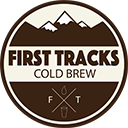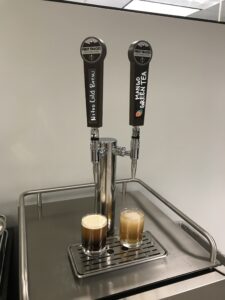Office Kegerators for the Breakroom
More and more kegerators have become standard equipment in the trendy offices of the 2020’s. Even with companies going remote or at least a hybrid model, you can make an argument for getting a kegerator for your staff to enjoy during those times where they are in the office. In Denver we have a ton of new construction. Weekly we have companies moving into new buildings with gorgeous break rooms and new apartments are going up which boast First Tracks Cold Brew Coffee and Tea among their amenities.
Obviously, we’re not driving the installation of kegerators in the Denver Metro area, coffee is not even the reason there are so many kegerators. One of the great things about kegerators is that there is so much diversity in what can be served out of them. Honestly, nearly any cold drink you want can be served out of a kegerator, it all depends on what you want to offer your customers, staff or clientele. What we hope to go over here are the drink options and equipment best suited for each option so you can make a fully informed decision when you decide what to serve on tap.
Coffee:
Nitro vs Still Cold Brew: Right now nitro coffee is the most popular non-beer beverage found in offices and apartments. It’s delicious, widely known, accepted and drank. It is also highly customizable, pouring a nitro cold brew doesn’t have to end with the coffee. You can easily personalize your drink with your choice of syrups or milks. The decision point in coffee is going to be between cold brew coffee and cold brew served on nitro. The difference being that nitro cold brew has a thick creamy head like a Guiness as opposed to flat coffee with no bubbles or foam. The main difference between these is the the texture. The nitro cold brew has a creamy texture and is more often served without ice. Flat or still cold brew will simply be the coffee without the creamy texture.
Equipment:
- GAS: Regardless of whether you serve nitro cold brew or still, coffee will need to be pressurized with nitrogen (N2). Often mistaken for nitrous, coffee is pressurized with the same nitrogen that makes up 78% of the air we breathe. Nitrogen is inert, meaning it won’t impart any weird flavors in the coffee like Carbon Dioxide or a blend would. It also does not have oxygen in it so it prohibits the growth of microbes that cause the coffee to go bad. If you are getting coffee from someone who is providing something other than pure nitrogen, find another supplier.
- REGULATOR: If using 100% nitrogen, you will need a nitrogen regulator. To prevent mixing up of gasses, the valves on nitrogen tanks and CO2 tanks are different. Nitrogen regulators (male) screw into a nitrogen tank, CO2 regs (female) screw onto CO2 tanks. Regulators are adjustable, meaning you can change the pressure the gas comes out of the tank and into the keg. For Nitro you are shooting for around 40 psi and for still you want about 10 psi. The higher pressure forces the nitrogen into solution allowing for the head on nitro cold brew. Preferably you want 2 gauges, one reading how much gas is in the tank, the other reading how much pressure is going into the keg.
- KEGS: Unless you plan on doing the brewing your self (which is possible but a pain) the keg will come with the coffee you’re getting from
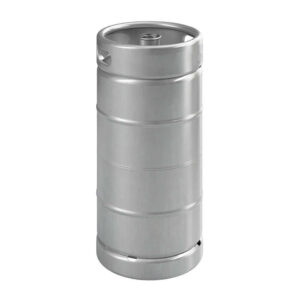 your supplier. You may want to ask if there is a keg deposit because some places will require one, other’s many not. One thing to be aware of is the type of keg. The two standard keg types for coffee are sanke kegs and cornelius (corny) kegs. Both have their pluses and minuses. Ultimately you need to be aware so the kegerator is compatible with the kegs you get your coffee from. It’s about a 50/50 chance whether it would be sanke or corny kegs. Conversion from one to another is easy so it shouldn’t be a make or break your decision on who to use for your cold brew supplier. Just be aware if you’re set up with one, you may have to pay a few bucks to swap over. Most packages from places like Beverage Factory or kegerator.com will include a corny keg if you are purchasing a “nitro coffee package” That’s not always necessary,
your supplier. You may want to ask if there is a keg deposit because some places will require one, other’s many not. One thing to be aware of is the type of keg. The two standard keg types for coffee are sanke kegs and cornelius (corny) kegs. Both have their pluses and minuses. Ultimately you need to be aware so the kegerator is compatible with the kegs you get your coffee from. It’s about a 50/50 chance whether it would be sanke or corny kegs. Conversion from one to another is easy so it shouldn’t be a make or break your decision on who to use for your cold brew supplier. Just be aware if you’re set up with one, you may have to pay a few bucks to swap over. Most packages from places like Beverage Factory or kegerator.com will include a corny keg if you are purchasing a “nitro coffee package” That’s not always necessary,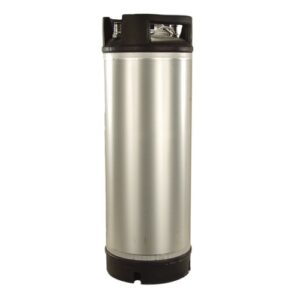 considering your supplier probably doesn’t want it, unless you are able to negotiate handing it over in lieu of a deposit.
considering your supplier probably doesn’t want it, unless you are able to negotiate handing it over in lieu of a deposit.
- FAUCET: For nitro cold brew you will need a stout faucet. It is longer than a traditional faucet because as the coffee is pushed through it agitates it and causes the nitrogen to come out of solution resulting in the head so desirable in nitro cold brew. Still cold brew can be poured out of a standard faucet.
Nitro Based Beverage Checklist:
- 100% Nitrogen –
- Nitrogen Regulator set to 40 – 43 psi
- Stout faucet
- Compatible fittings for Sanke or Cornelius keg
Kombucha/Seltzer your CO2 Beverages:
The next most popular beverage in our experience is kombucha. Kombucha is a fermented tea that is rich with probiotics and is popular among the younger set looking for an alternative to caffeine and alcohol. You can get hard (alcoholic) kombucha but more often than not it’s non-alcoholic. Kombucha can still served out of a kegerator but the equipment and needs are a bit different.
Seltzer has had a real moment in the past couple of of years. The explosion of seltzer and the popularity of beer in cans has actually caused an increase in prices of those aluminum cans that will soon be reflected in prices over 2022. The thing is, if you’re talking about non-alcoholic seltzer, it’s the easiest thing in the world to make. All plain seltzer is, filtered water and CO2 and some kind of flavoring. How much flavor and what kind is up to you and can range from high sugar/flavor like a soft drink to something that tastes like your drinking plain seltzer but looking at a coconut like la croix.
GAS: Kombucha uses CO2 which is the same gas used for beer. It will cause the kombucha to have a bitter bubbly flavor similar to seltzer which is what you want.
REGULATOR: You’ll need a CO2 regulator to go with that tank. Exactly the same as the nitrogen regulator but with a different fitting to attach to the CO2 tank.
KEGS: Like a cold brew coffee keg you’ll see these beverages come in both sanke and corny kegs. Again there is no real difference to you, the consumer, but there will be opinions among kombucha wholesalers based on their volume and brewing methods, facilities.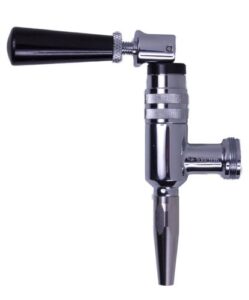
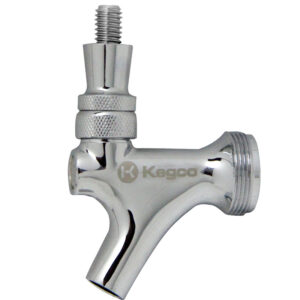 FAUCET: For kombucha and seltzer, all you’ll need is a standard faucet, since you are using CO2 to pressurize and flavor running these through an agitator will cause it to foam up to much and will result in flat beverage which is no bueño.
FAUCET: For kombucha and seltzer, all you’ll need is a standard faucet, since you are using CO2 to pressurize and flavor running these through an agitator will cause it to foam up to much and will result in flat beverage which is no bueño.
CO2 beverage-based Checklist
- 100% CO2 5lb cylinder
- CO2 Regulator set to 6-12 psi
- Standard Faucet
- Compatible fittings for sanke or Cornilus kegs
The Kegerator Itself:
There are so many different types of kegerators available on the market these days. There are a few features you need to be on the lookout for.
- Installation: Will it be built in or free-standing. A built-in kegerator will have ventilation in the front so the unit doesn’t overheat. A free standing unit will be on wheels and can be moved around easily which is nice if you ever want to move it for an event of some sort.
- Thermostat: Thermostats range from simple dials to fancy digital displays. The digital displays are nice because you can dial into a specific temperature rather than an arbitrary number between 1 and 10. It’s also nice because it is typically displayed just inside the top of the door. This keeps it out of the way of the kegs inside when space is at a premium.
- Let’s talk space, most public facing kegerators, those in offices or apartment community rooms are not going to need space for a full size keg or a ½ barrel, the size you typically got in college and put in a huge trashcan covered with ice. Worst case scenario you will need space inside for 2-5 gallon corny kegs, 2 ⅙ bbl sankes or a combination of the two. Inside the keg you’ll also need space for up to 2 small gas tanks if you have beverages with different gas requirements i.e. kombucha and coffee.
Aside from these primary thoughts, go with what you can afford. Personally, we like Edgestar and Summit but in all honesty, a lot of kegerator brands come from one factory and get a brand name slapped on it after the fact.
This is… a lot. If you have additional questions, thoughts, comments or input, let us know. We’d love to hear from you, reach out to us at info@firsttrackscoldbrew.com or give us a call at 720-563-7875. And if you’re in the Denver area and are even thinking about cold brew coffee, give us a call, we can walk you through start to finish.
Cheers,
A
